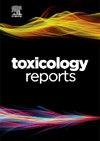Transgenerational toxicity of Aroclor 1232 by inhalational route in mouse model
Q1 Environmental Science
引用次数: 0
Abstract
Background
Aroclor 1232 is a commercial mixture of polychlorinated biphenyls with inhalational toxicological implications as it contains semi-volatile congeners like PCB 77, along with highly lipophillic ones like PCB 180. We aimed to assess the trans-generational behavioral toxicities of this complex mixture in mice by inhalational dosing chamber. We also aimed to evaluate the penetrability of PCBs across placental and lactational routes in mice in this study.
Methods
We assessed the probable route of penetration in the first generation of litters using behavioral scores as surrogate markers of developmental toxicity. We also quantified plasma concentrations of key PCBs and anthropometric parameters for trans-generational comparability.
Results
PCBs are responsible for behavioral toxicities across one generation of mice by hazardous exposures via the inhalational route. Behavioral scores of F1 and F2generation mice indicated as surrogate endpoints that PCBs are concentrated in lactating milk more than placental route in the next generation of mice. No significant lethality or effects on anthropometrical parameters were detected across one generation although the congeners were detected in plasma of the litters when they were 12–14 weeks age.
Conclusion
PCBs may pose both indoor and outdoor volatile hazard by inhalational routes and cause behavioral deficits across one generation by transfer via lactational routes. PCB 77 is more evident of penetrating trans-generationally and produces behavioral toxicities in subsequent generations. They definitely carry inhalational hazard in workplaces and outdoor as environmental pollutants and neuroendocrine disruptors.
阿罗克罗1232经吸入途径对小鼠的跨代毒性作用
daroclor 1232是一种商用多氯联苯混合物,具有吸入毒性,因为它含有半挥发性同系物,如PCB 77,以及高亲脂性同系物,如PCB 180。我们的目的是通过吸入给药室评估这种复杂混合物对小鼠的跨代行为毒性。在本研究中,我们还旨在评估多氯联苯在小鼠胎盘和哺乳期途径中的渗透能力。方法采用行为评分作为发育毒性的替代指标,对第一代窝鼠可能的渗透途径进行评估。我们还量化了关键多氯联苯的血浆浓度和跨代可比性的人体测量参数。结果spcb可通过吸入途径对一代小鼠产生行为毒性。F1代和f2代小鼠的行为评分作为替代终点表明,下一代小鼠多氯联苯在乳汁中的浓度高于胎盘途径。虽然在12-14周龄的幼崽血浆中检测到同系物,但在一代中未检测到显著的致死率或对人体测量参数的影响。结论多氯联苯可通过吸入途径对室内和室外产生挥发性危害,并可通过哺乳期途径转移,造成一代行为缺陷。多氯联苯77的跨代渗透更为明显,并在后代中产生行为毒性。作为环境污染物和神经内分泌干扰物,它们在工作场所和室外肯定会带来吸入危害。
本文章由计算机程序翻译,如有差异,请以英文原文为准。
求助全文
约1分钟内获得全文
求助全文
来源期刊

Toxicology Reports
Environmental Science-Health, Toxicology and Mutagenesis
CiteScore
7.60
自引率
0.00%
发文量
228
审稿时长
11 weeks
 求助内容:
求助内容: 应助结果提醒方式:
应助结果提醒方式:


